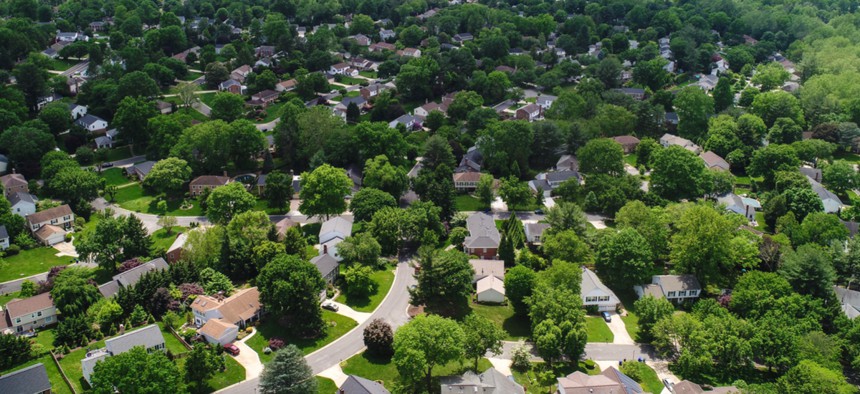Throwing Shade: Reducing Urban Temperatures by Planting Trees

Urban areas typically have more impervious surfaces, which trap heat and raise temperatures. Shutterstock

Connecting state and local government leaders
A Maryland county is planting free trees in urban areas to increase shaded areas and lower temperatures.
Throughout Montgomery County, Maryland, officials are trying to make things a little more green—by offering to plant free trees on qualifying parcels of land in certain urban areas.
The program, dubbed Shades of Green, began in 2011 as a way to increase the network of leaves and branches that cover the county when viewed from above, known as the urban tree canopy. A healthy tree canopy has been shown to reduce temperatures in urban areas by shading impervious surfaces, preventing sunlight from beating down on asphalt and radiating heat back out into the community.
Montgomery County’s business districts and urban areas “should have at least 25 percent tree canopy to maintain a healthy environment,” according to a 2011 analysis. But eleven of the 17 urban areas included in the analysis had less, ranging from 8 percent (Montgomery Hills) to 24 percent (the Bethesda Central Business District).
“These are areas that typically have the most impervious surfaces and the fewest trees. It’s just much higher in temperature than if you were to go into a residential neighborhood or a park,” said Tina Schneider, a senior environmental planner with the Montgomery County Planning Department. “They’re what we call heat islands, so we want to try to cool them. By planting as much as we can in those areas, it will lower the temperature, improve air quality and cool the surfaces, which provides habitat for animals and pollinators and places for people to sit.”
The program has since expanded to include 21 urban areas, most of them dominated by commercial properties. Those areas are most in need of tree canopy, but the nature of development there makes it difficult to find suitable planting space with adequate soil volume for trees to flourish, Schneider said.
“We need to have enough soil volume so the trees can survive, and we don’t want trees to be planted in the right-of-way because Pepco and other utility companies can come remove those trees,” she said. “We take the boundaries of the urban districts and look at every piece of land in the urban area, and we say, ‘Where can we plant trees, where is there enough soil?’ Then we’re targeting those landowners by sending flyers and trying to encourage them to allow us to plant trees on their properties.”
The trees are paid for via the Forest Conservation Fund, financed through fees paid by developers when trees are cut down during construction projects. The money was previously earmarked for reforestation projects, but the state Department of Natural Resources loosened those restrictions in 2009, allowing the fund to also be utilized for growing urban tree canopy.
To qualify, properties—commercial or residential—must be located within the boundaries of one of the county’s eligible urban areas. County planners will schedule a site evaluation for qualifying properties to “confirm adequacy of space and location,” according to the county’s website. Trees are planted in the spring and fall, and if a tree dies within a year of being planted, the county will replace it.
Since the beginning of the Shades of Green program, county workers have planted 147 trees in Wheaton, Silver Spring and Bethesda. All are species native to Montgomery County, including white oak, northern red oak, river birch, honey locust and sycamore.
Officials are hoping to ramp up participation in the program by targeting one district per planting season through direct mailings and social media. The ultimate goal is to get 25 to 40 percent tree canopy in urban areas, though finding adequate planting space is a significant challenge.
“That’s another reason why this program is slow going. It’s extremely hard to find places to plant trees,” Schneider said. “Sometimes there are parking lots, and we can do it there, but your average commercial property is either already landscaped or there’s just no opportunity to landscape. We’re slowly going region by region and doing this analysis. It’s a program that is just starting to really move ahead.”
Kate Elizabeth Queram is a Staff Correspondent for Government Executive’s Route Fifty and is based in Washington, D.C.

NEXT STORY: The Impacts of Iowa’s Underground Needle Exchanges




